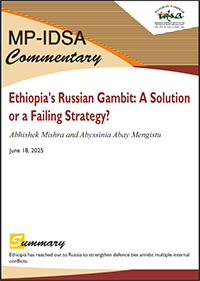Ethiopia’s Russian Gambit: A Solution or a Failing Strategy?
- June 18, 2025 |
- IDSA Comments
Russia’s use of quasi-private military companies like the erstwhile Wagner Group and now the ‘Africa Corps’, particularly in Africa’s Sahel region, attest to its expanding footprint in Africa. However, this footprint is not limited to the Sahel. It extends to the Horn of Africa (HoA) and the strategic Red Sea region where Russia seeks to maintain a sustained presence. In this effort, Ethiopia—a regional heavyweight facing international scrutiny over its ongoing civil conflict, much like Russia—has become a significant partner for Moscow.
Ethiopia’s ascent to BRICS membership in 2024 has opened new avenues of dialogue with Russia including relating to naval cooperation, trade in local currencies, civil nuclear cooperation, and more recently, defence and security engagement.
In the end of May 2025, a high-level Ethiopian delegation led by Chief of the General Staff Field Marshal Birhanu Jula Gelalcha met senior Russian defence officials to discuss the progress of their strategic bilateral military ties.i Both sides emphasised the importance of maintaining regional stability and agreed to improve professional military communication among their respective armed services. Such military overtures by Ethiopia to Russia (ostensibly to buy arms and strengthen defence ties) reflect a desperate attempt to salvage a crumbling security posture amid multiple, intensifying internal conflicts in Ethiopia.
Internal Conflicts in Ethiopia
Ethiopia has been devastated by perpetual bouts of conflict between the Tigray region and the federal government led by Prime Minister Abiy Ahmed, leading to loss of lives and thousands of internally displaced persons.
The present crisis in Ethiopia, particularly in the Amhara region, is largely fuelled by ongoing political instability, power struggles and persistent ethnic tensions between the Amhara and Oromo communities. This has resulted in the federal government, the Fano militia, and the Oromo Liberation Army (OLA) engaged in a continuous power struggle.
In recent days, the OLA has escalated attacks including retaliatory strikes in Oromia, and these actions have deepened instability in Ethiopia’s most populous region, stretching federal security resources thin and undermining the government’s legitimacy among the Oromo population.
The Fano militia, once an ally against the Tigray People’s Liberation Front (TPLF), now controls vast swathes of rural Amhara and has launched repeated offensives against federal forces.ii The government has failed to defeat Fano despite heavy military investment, including drone strikes and air campaigns. The conflict has displaced over 100,000 people, left millions of children out of school, and led to widespread human rights abuses by both sides.
The Fano militia is perceived to be disorganised, with several insurgent factions within it that operate independently. The Fano militia is, however, slowly becoming more organised, although this development is at a nascent stage. Fano’s decentralised structure and broad public support make it resilient,iii while the Ethiopian government’s attempts to negotiate are undermined by a lack of meaningful concessions and a preference for military suppression. The cumulative effect of these two rebel forces will inevitably have a detrimental effect on an already staggered regime and/or country.
Equally worrisome is that Eritrea, once a temporary ally against Tigray, is now mobilising troops and may be exploring new alliances with splintered Tigrayan factions.iv This, in turn, threatens to encircle Ethiopia with hostile forces, making Abiy’s security strategy even more precarious. This is because the TPLF’s fragmentation has not led to peace but rather to new, unpredictable actors in the north, further destabilising the region.
The Ethio-Russia Gambit: Why It Will Fail
Panic Buying, Not Strategy
Ethiopia’s arms purchase from Russia are a panic response to internal disintegration, not a coherent strategy. The government is losing ground to multiple insurgencies and cannot rely on imported firepower to restore control.
Resource Stretching
The military is already overstretched, fighting Fano in Amhara, OLA in Oromia, and facing potential new threats from Eritrea and Tigray. Russian arms may bolster firepower, but they won’t address the root causes of conflict—political exclusion, ethnic grievances and lack of trust in the central government.
Human Rights and Legitimacy
The government’s heavy-handed tactics—including drone strikes and alleged war crimes—have eroded its legitimacy and fuelled recruitment for insurgent groups. This sentiment has been echoed recently by the United States Ambassador to Ethiopia Ervin Massinga.v More so, Russia has little interest in Ethiopia’s long-term stability; its primary aim is to sell arms and gain influence.
No Real Peace Process
The government’s ‘peace’ initiatives are superficial, focusing on fragmenting insurgents rather than addressing their grievances. Without genuine political dialogue and reconciliation, even the most advanced weaponry will not bring stability.
In general, a cynical observer might argue that Ethiopia is becoming a proxy battleground for external powers: Russia, the West, and regional players like Eritrea and Somalia. The real winners are arms dealers and opportunists. The losers will be civilians, peace and any hope of genuine stability.
In the current context, Ethiopia’s pivot to Russia for arms is not just about modernising its military but a panic buy. With the Pretoria peace deal in tatters, Tigrayan factions splintering, and Eritrea mobilising, Ethiopia’s incumbent’s government is buying time—and firepower. But Russian weapons alone will not solve Ethiopia’s deeper problems: a divided military, a restless populace, and a leadership increasingly isolated from both the West and its own people.
Conclusion: A Failing Strategy
The Ethio-Russia gambit is a symptom of a government in crisis, not a cure. Ethiopia’s internal conflicts—driven by the OLA, Fano and potential Eritrea–Tigray alliances—are rooted in deep-seated political and ethnic grievances that cannot be resolved by military hardware alone. The government’s reliance on Russian arms is a short-term fix that will only deepen the country’s fragmentation and prolong suffering. In the end, this strategy is likely to fail, leaving Ethiopia more divided and unstable than ever.
A fractured Ethiopia, mired in conflict, may subsequently lead to an increasingly instable HoA region. With Ethiopia now signalling its intent to procure Russian weapon systems, one may argue that it could be a possible preparation for a second round of conflict between Prime Minister Abiy’s federal government forces, the TPLF and external actors like neighbouring Eritrea.
i Chinedu Okafor, “New Era For Russia-Ethiopia Relations As Defense, Currency And BRICS Deal Unfolds”, Business Insider Africa, 27 May 2025.
ii Martin Plaut, “Ethiopia: The Fano and the Regime’s War in the Amhara Region”, Africa, Ethiopia, Horn of Africa, Uncategorized, 8 March 2025.
iii “Africa File, September 26, 2024: FANO Offensive in Ethiopia’s Amhara; Egypt Arms Somalia; Rebel Drones in Mali; Burkina Thwarts Another Coup”, Institute for the Study of War, 26 September 2024.
iv “Ethiopia and Eritrea Slide Closer to War amid Tigray Upheaval”, Reliefweb, 27 March 2025.
v Getahun Tsegaye, “U.S. Ambassador to Ethiopia Says Statement on Drone Strike Retracted Due to ‘Administrative Error’”, Borkena, 12 June 2025.







